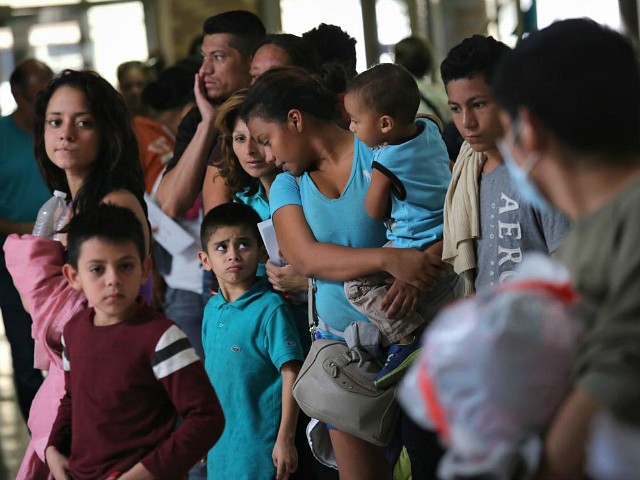
President Donald Trump’s draft plan to exclude welfare-dependent migrants is justified by data showing that almost two-thirds of households headed by non-citizens use at least one welfare program, says the Center for Immigration Studies (CIS).
“In 2014, 63 percent of households headed by a non-citizen reported that they used at least one welfare program, compared to 35 percent of native-headed households,” says the group’s December 3 report, which relies on federal data to track migrant use of welfare.
“A very large share of immigrants are unable to support their own children and turn to taxpayer-funded means-tested programs,” the report says. “In terms of the policy debate over immigration and the implications for public coffers, this is the central concern.”
The report was issued because pro-migration groups are asking judges to block Trump’s pending “public charge” regulation. The draft regulation would allow officials to enforce a long-standing, long-ignored law which says officials should deny green cards to illegal migrants or legal visitors who are a “public charge” when they ask for an “Adjustment of Status” to get green cards.
The CIS report says:
Welfare use tends to be high for both newer arrivals and long-time residents. Of households headed by non-citizens in the United States for fewer than 10 years, 50 percent use one or more welfare programs; for those here more than 10 years, the rate is 70 percent.
Welfare use tends to be high for both newer arrivals and long-time residents. Of households headed by non-citizens in the United States for fewer than 10 years, 50 percent use one or more welfare programs; for those here more than 10 years, the rate is 70 percent.
The migrants’ use of welfare is not a matter of migrant laziness, but it caused by the convergence of migrants’ poor education, widespread low wages, and the breadth of the nation’s myriad welfare and support programs, the report notes. It says:
The primary reason welfare use is so high among non-citizens is that a much larger share of non-citizens have modest levels of education and, as a result, they often earn low wages and qualify for welfare at higher rates than natives.
Of all non-citizen households, 58 percent are headed by immigrants who have no more than a high school education, compared to 36 percent of native households.
The vast majority of migrant households include working adults.
The data shows there is at least one working adult in 93 percent of the 4,684,784 million non-citizen households in the United States, the report says. Roughly half of those non-citizens are illegal aliens, with the rest being visitors, temporary workers, or green-card holders who can become citizens.
In September, Breitbart News reported on the pending regulation. The agency’s statement says:
“the Department of Homeland Security (DHS) announced a proposed rule that will clearly define long-standing law to ensure that those seeking to enter and remain in the United States either temporarily or permanently can support themselves financially and will not be reliant on public benefits … [or] likely to become burdens on American taxpayers.”
DHS is proposing to consider current and past receipt of designated public benefits above certain thresholds as a heavily weighed negative factor. The rule would also make nonimmigrants who receive or are likely to receive designated public benefits above the designated threshold generally ineligible for change of status and extension of stay.”
…
The phrase “heavily weighed negative factor” implies that most — but not all — poor, sick and unskilled applicants will not be given residency.
The regulation does not count taxpayer aid related to the Affordable Care Act or the Children’s Health Insurance Program, and it excludes taxpayers’ rebates under the Earned Income Tax Credit. The rule also allows would-be immigrants to receive a small amount of aid, or roughly $3,765 for a family of four, or a $1,821 for a single person. The rules only apply once the regulation is established, so it does not cover potential migrants’ current use of aid programs.
In the United States, the establishment’s economic policy of using migration to boost economic growth shifts wealth from young people towards older people by flooding the market with cheap white-collar and blue-collar foreign labor. That flood of outside labor spikes profits and Wall Street values by cutting salaries for manual and skilled labor offered by blue-collar and white-collar employees.
The policy also drives up real estate prices, widens wealth-gaps, reduces high-tech investment, increases state and local tax burdens, hurts kids’ schools and college education, pushes Americans away from high-tech careers, and sidelines at least five million marginalized Americans and their families, including many who are now struggling with opioid addictions.
Immigration also pulls investment and wealth away from heartland states because coastal investors can more easily hire and supervise the large immigrant populations who prefer to live in the coastal states.
via Breitbart News
Enjoy this article? Read the full version at the authors website: https://www.breitbart.com
